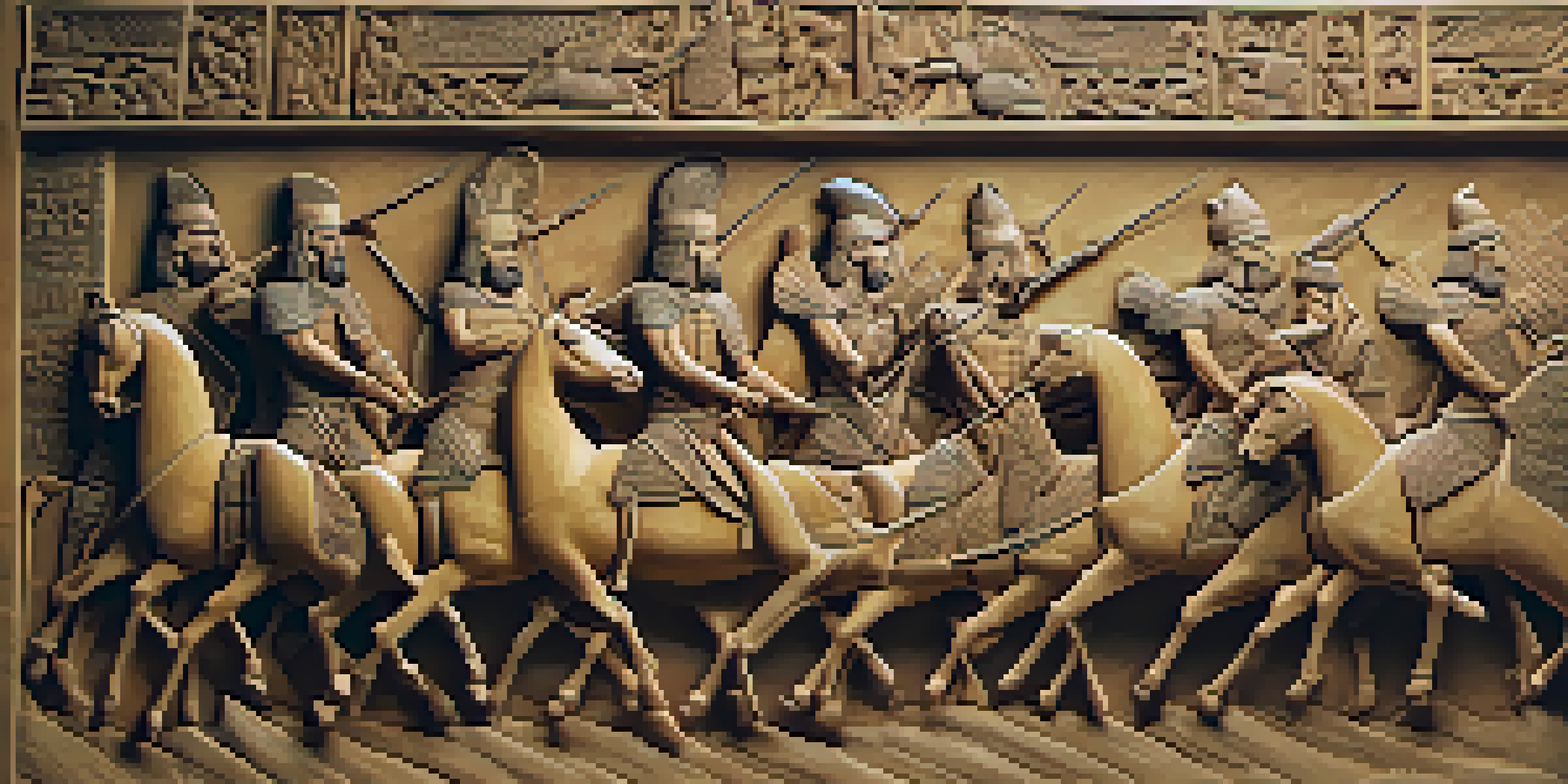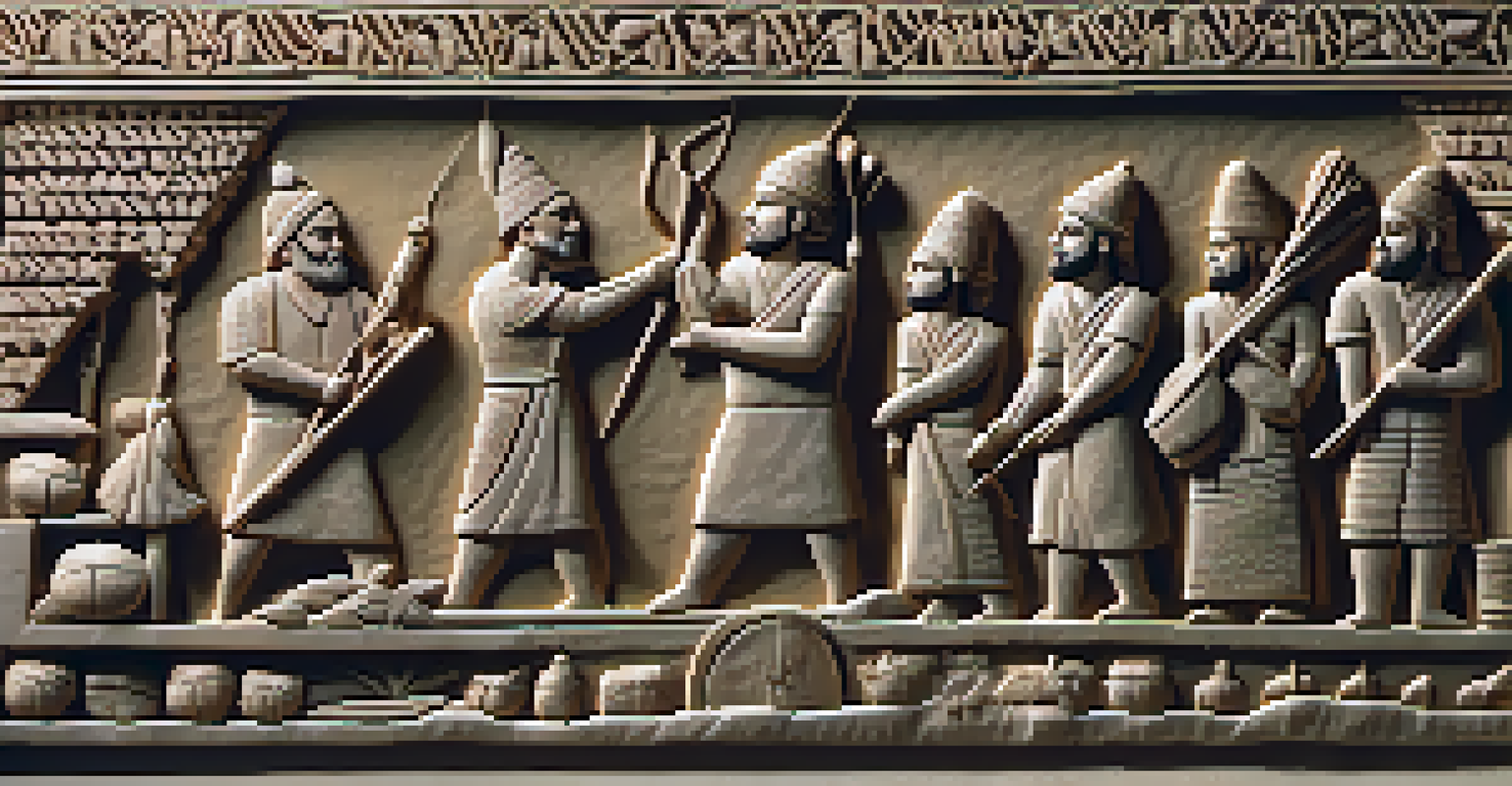Cultural Significance of Carved Reliefs in Mesopotamia

Introduction to Mesopotamian Carved Reliefs and Their Context
Mesopotamia, often referred to as the cradle of civilization, is home to some of the world's earliest art forms, including carved reliefs. These artistic depictions were not only decorative but served as vital storytelling mediums that conveyed cultural narratives. Carved reliefs typically adorned the walls of temples and palaces, capturing significant events, deities, and daily life.
Art is the most beautiful of all lies.
The creation of these reliefs dates back to ancient civilizations like the Sumerians, Akkadians, Babylonians, and Assyrians. Each culture added its unique flair, reflecting its beliefs and societal values. For instance, the Assyrian reliefs often depicted scenes of conquest and power, showcasing their military prowess and divine favor.
Understanding the context of these artworks enriches our appreciation of their cultural significance. They reveal a lot about the social hierarchies, religious practices, and daily lives of the people who created them, making them invaluable resources for historians and archaeologists alike.
Symbolism and Themes in Carved Reliefs
One of the most fascinating aspects of Mesopotamian carved reliefs is their rich symbolism. Many reliefs feature deities, animals, and mythical creatures, each imbued with specific meanings that resonate with the culture’s beliefs. For example, the lion was often associated with power and protection, frequently depicted alongside kings to symbolize their might.

Reliefs also often portray scenes of agricultural abundance, reflecting the importance of farming in Mesopotamian society. These depictions not only celebrate the bounty of the land but also serve as a reminder of the people's dependence on the gods for favorable conditions. This intertwining of daily life and spirituality illustrates how art served as a bridge between the two.
Cultural Significance of Reliefs
Mesopotamian carved reliefs served as vital storytelling mediums that reflected the cultural narratives, beliefs, and daily lives of ancient civilizations.
Additionally, themes of warfare, conquest, and divine intervention are prevalent. These reliefs often depict kings in battle, showcasing their bravery and the belief that their victories were sanctioned by the gods, reinforcing the idea of divine right to rule.
The Role of Carved Reliefs in Religious Practices
Carved reliefs played a crucial role in the religious life of ancient Mesopotamians. Many reliefs were created for temples, where they depicted gods and goddesses, serving both as decorative elements and objects of worship. These artworks were believed to invite the presence of deities into the space, making them central to religious rituals.
The past is never dead. It's not even past.
Moreover, the intricate detailing often served as a form of devotion, showcasing the skills of artisans and their reverence for the divine. The scenes portrayed in these reliefs often depicted myths and legends that were integral to the culture's spiritual beliefs, allowing worshippers to connect with their deities on a more personal level.
Through these artworks, the ancient Mesopotamians communicated their values, fears, and aspirations, creating a visual narrative that transcended the written word. This interplay of art and spirituality highlights how deeply intertwined these elements were in their daily lives.
Carved Reliefs as Historical Records
Beyond their artistic beauty, carved reliefs serve as vital historical records that document the achievements and events of ancient Mesopotamian civilizations. They provide insights into the political landscape, showcasing the rulers, their conquests, and their interactions with other cultures. This aspect is particularly evident in Assyrian reliefs that often celebrate military victories.
These artworks can also reveal information about trade, technology, and social organization in ancient societies. For example, reliefs depicting the transportation of goods or the construction of temples highlight the economic activities and labor practices of the time. Such scenes are invaluable for understanding the complexities of Mesopotamian life.
Artistry and Craftsmanship
Creating these reliefs required immense skill, with artisans using soft stones and intricate techniques to produce detailed and expressive artworks.
Moreover, carved reliefs can shed light on the daily lives of ordinary people. Scenes of banquets, farming, and family life offer a glimpse into the customs and social norms of the time, making these pieces a rich source for both historians and anthropologists.
The Artistic Techniques Behind Carved Reliefs
Creating carved reliefs required immense skill and artistry, showcasing the craftsmanship of ancient Mesopotamian artisans. Typically, these artists worked with soft stone, such as limestone or alabaster, which allowed for detailed carvings. The process involved chiseling away layers of stone to create images that could range from shallow to deep reliefs, adding depth and dimension.
The techniques varied between cultures but often included intricate detailing that brought scenes to life. Artists employed tools made from bronze or stone to achieve fine lines and patterns, which were essential for highlighting features such as clothing, hair, and facial expressions. This attention to detail not only demonstrated their technical prowess but also their understanding of aesthetics.
The finished reliefs were often painted in vibrant colors, which have mostly faded over time but would have added to their visual impact. This interplay of craftsmanship and artistic vision highlights why these reliefs are not just historical artifacts but also masterpieces of ancient art.
Preservation and Study of Carved Reliefs Today
Today, the preservation of Mesopotamian carved reliefs poses significant challenges due to factors like environmental degradation and human activity. Many reliefs are found in archaeological sites that are at risk from natural erosion or urban expansion. Efforts to protect these invaluable artifacts are crucial for future generations to appreciate and learn from.
Archaeologists and conservators are employing advanced technologies, such as 3D scanning and digital modeling, to document and analyze these reliefs. This technology not only aids in preservation efforts but also enhances our understanding of their original context and significance. It allows researchers to reconstruct missing pieces and analyze the artworks in unprecedented detail.
Preservation Challenges Today
Modern efforts to preserve Mesopotamian carved reliefs face significant challenges from environmental degradation and human activity, necessitating advanced conservation techniques.
Furthermore, museums and institutions are increasingly focusing on education and outreach to raise awareness about the importance of these artifacts. By engaging the public, they foster a greater appreciation for Mesopotamian culture and encourage support for preservation efforts.
Conclusion: The Enduring Legacy of Mesopotamian Carved Reliefs
The carved reliefs of Mesopotamia are more than mere decorations; they are windows into the past, offering insights into the cultural, spiritual, and historical fabric of ancient civilizations. Their intricate designs and rich symbolism continue to captivate scholars, artists, and enthusiasts alike, ensuring their relevance even today. Through these artworks, we can trace the evolution of human thought and expression.
As we explore these ancient masterpieces, we gain a deeper appreciation for the craftsmanship and creativity that have survived the test of time. Each relief tells a story, preserving the voices of those who lived thousands of years ago, allowing us to connect with their experiences and emotions.

In celebrating the legacy of Mesopotamian carved reliefs, we honor not only the artistic achievements of the past but also the enduring human quest for meaning, connection, and expression.